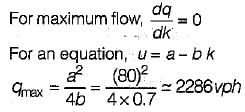Civil Engineering (CE) Exam > Civil Engineering (CE) Tests > Test: Traffic Engineering- 1 - Civil Engineering (CE) MCQ
Test: Traffic Engineering- 1 - Civil Engineering (CE) MCQ
Test Description
10 Questions MCQ Test - Test: Traffic Engineering- 1
Test: Traffic Engineering- 1 for Civil Engineering (CE) 2025 is part of Civil Engineering (CE) preparation. The Test: Traffic Engineering- 1 questions and answers have been prepared
according to the Civil Engineering (CE) exam syllabus.The Test: Traffic Engineering- 1 MCQs are made for Civil Engineering (CE) 2025 Exam.
Find important definitions, questions, notes, meanings, examples, exercises, MCQs and online tests for Test: Traffic Engineering- 1 below.
Solutions of Test: Traffic Engineering- 1 questions in English are available as part of our course for Civil Engineering (CE) & Test: Traffic Engineering- 1 solutions in
Hindi for Civil Engineering (CE) course.
Download more important topics, notes, lectures and mock test series for Civil Engineering (CE) Exam by signing up for free. Attempt Test: Traffic Engineering- 1 | 10 questions in 30 minutes | Mock test for Civil Engineering (CE) preparation | Free important questions MCQ to study for Civil Engineering (CE) Exam | Download free PDF with solutions
Detailed Solution for Test: Traffic Engineering- 1 - Question 1
Test: Traffic Engineering- 1 - Question 2
Which of the following is indicated by a warning sign?
Test: Traffic Engineering- 1 - Question 3
Which of the following shows skewed and staggered form of intersection?
Detailed Solution for Test: Traffic Engineering- 1 - Question 4
Detailed Solution for Test: Traffic Engineering- 1 - Question 5
Detailed Solution for Test: Traffic Engineering- 1 - Question 7
Test: Traffic Engineering- 1 - Question 8
The PCU (passenger car unit) value for car on an urban road is
Detailed Solution for Test: Traffic Engineering- 1 - Question 8
Test: Traffic Engineering- 1 - Question 9
Traffic flow equation for a section of road is u = 80 - 0.7 K where ‘u’ is the speed in kmph and ‘K’ is the density in vpkm (vehicles per km). The maximum expected flow is
Detailed Solution for Test: Traffic Engineering- 1 - Question 9
Test: Traffic Engineering- 1 - Question 10
During measurement in spot speed study, a total of 1000 vehicles were observed. 85 per centile and 15 percentile speeds were obtained as 40 kmph and 10 kmph respectively. The number of vehicles moving between speeds of 10 kmph and 40 kmph would be:
Detailed Solution for Test: Traffic Engineering- 1 - Question 10
Information about Test: Traffic Engineering- 1 Page
In this test you can find the Exam questions for Test: Traffic Engineering- 1 solved & explained in the simplest way possible.
Besides giving Questions and answers for Test: Traffic Engineering- 1, EduRev gives you an ample number of Online tests for practice
Download as PDF




















